Author: CaptainZ Source: X, @hiCaptainZ
For a long time, when we talk about chain games, they are all based on smart contract platforms like ETH. The reason is also obvious, either take the GameFi route of asset-on-chain, or the full-chain game route of state-on-chain. No matter which route, using smart contracts is the simplest way to implement it. However, the emergence of inscriptions has allowed the non-smart contract platform BTC ecosystem to combine with the indexer to create a different technical implementation method. This article will make a technical summary of the exploration of BTC ecological games, the metaverse and the autonomous world, and see how Inscription and chain games are combined.
Another implementation of full-chain games
For a typical asset on the chain For GameFi games, whether it is issuing NFT or FT tokens, the smart contract platform is still the best choice without any hassle. So can the full-chain games that became popular last year be put on the BTC chain? This sentence sounds strange at first: the definition of a full-chain game is to write game logic and assets onto the chain (the logic is written into the smart contract virtual machine and the assets are issued using smart contracts). Since your smart contract functions are No, how to do it?
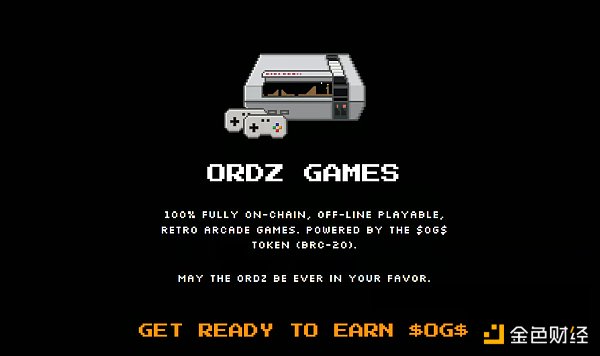
Just started seeing Ordz Game ( @OrdzGames) When he said that he was a fully on-chain game based on BTC, I was also curious. As we mentioned in the previous article, Inscription can upload any file to the BTC Segregated Witness space, and the upper limit of the size is 4M. As a result, domo uploaded "a JSON format code for currency issuance", which has already opened the BRC20 multi-billion dollar market. What if you upload a piece of game code to the chain? Ordz does just that.
For web-based mini-games, when players visit the game webpage, they will download the code to a local file in the browser, and then run the entire game directly in the browser. Therefore, the "Inscription Version Full Chain Game" only needs to provide an online storage space where the game code can be downloaded. BTC's Segregated Witness space provides such a DA layer. The principle is as follows:
Development: small games usually use HTML, CSS and JavaScript (JS) for development. HTML is responsible for the structure of the page, CSS handles styling and layout, and JavaScript is the core responsible for game logic, animation, and user interaction.
Hosting: The developed game code and resource files (such as pictures, audio, etc.) will be uploaded to the BTC Segregated Witness space. This way, users can load the game by visiting a specific URL through their browser. Although the logic and operation of the game are completely completed on the client (that is, the user's browser), the game files still need to be downloaded from the chain to the client.
Loading: When a user visits a game's web page, the browser downloads the HTML, CSS, and JavaScript files. These files contain all or most of the game's code.
Run: After the download is completed, the browser will parse the HTML and CSS to build the structure and style of the page. At the same time, the JavaScript code is executed in the browser's JavaScript engine.
Interaction: The user's interaction with the game (such as clicking, dragging, etc.) will be processed through JavaScript, and the game will be updated based on these interactions Game status and graphics. Because these processes are completed on the user's device, the response speed is fast and can provide a smooth gaming experience.
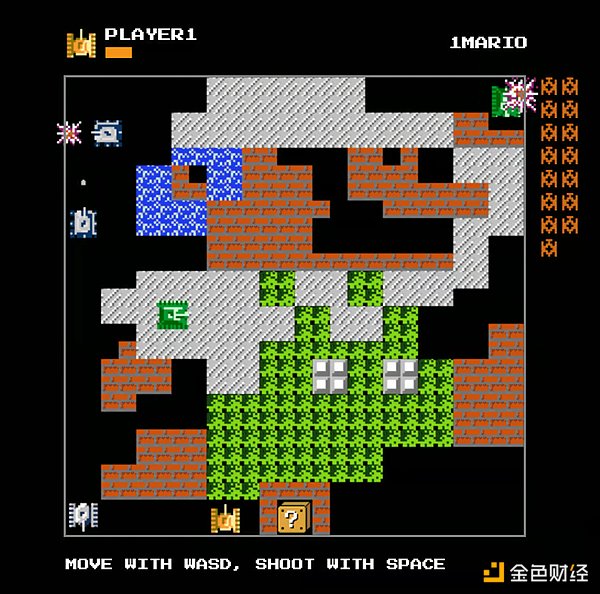
To sum up, although Ordz did upload all the game code to the chain, strictly speaking, it does not meet the definition of "fully on-chain game". After all, all the logic of the game is executed off-chain. . However, as a GameFi-type inscription mini-game, it has its own unique aspect, and it also issued its own inscription BRC20 token as a utility token (ORDG).
Bitmap as a map of the metaverse#
Bitmap (@bitmapdev) is known as the Bitcoin ecosystem The first Metaverse project was proposed by Twitter user @blockamoto on Twitter on June 13, 2023, and was subsequently followed and promoted by some media. Bitmap is based on Ordinals theory and Bitmap theory. Ordinal number theory is to assign a serial number to each sat, and bitmap theory is also very simple. It treats a block generated by Bitcoin every ten minutes as a map data based on the parameters of the data structure and defines some data formats. The combination of the two means that each block is treated as a map NFT, and then this NFT is bound to a certain sat using ordinal.
Bitmap theory itself only stipulates two basic rules:
1. Each area A block is defined as a "District", represented by the block height.
2. Each transaction in the block is defined as a "Parcel", counting from 0 in order.
The so-called "engraving" is to upload the serial number of the region and plot to the Segregated Witness space according to the format and bind it to sat. For example, for a block with a block height of 31209, the text (31209.bitmap) needs to be bound to sat to declare ownership. The fifth transaction in block 31209 needs to bind the text (5.31209.bitmap) to sat. But currently only the owner of "district" is allowed to imprint the ownership of "parcel".
Other sub-rules, including the meaning represented by input/output, the meaning represented by the number of block transactions, etc., can be defined separately by different projects. This is There are 2D versions of maps, 3D versions of maps, and VR versions of maps. . .
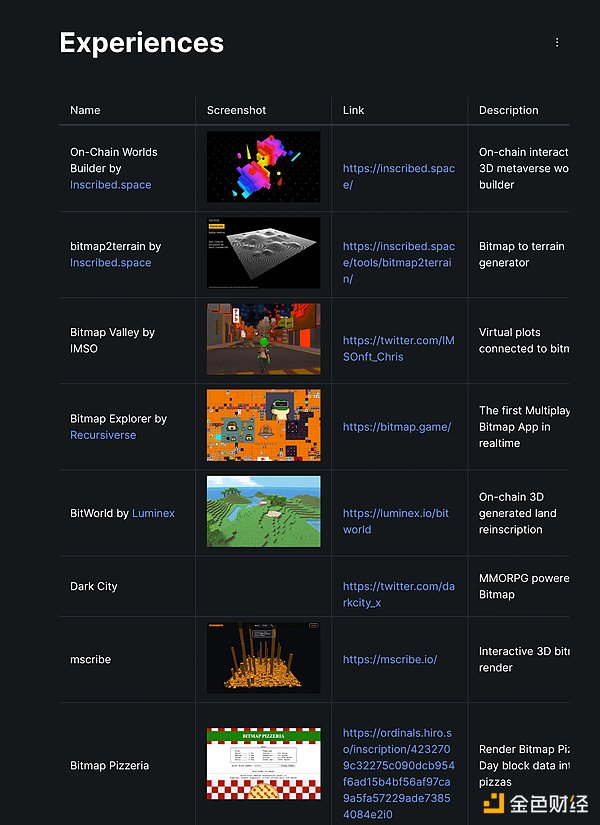
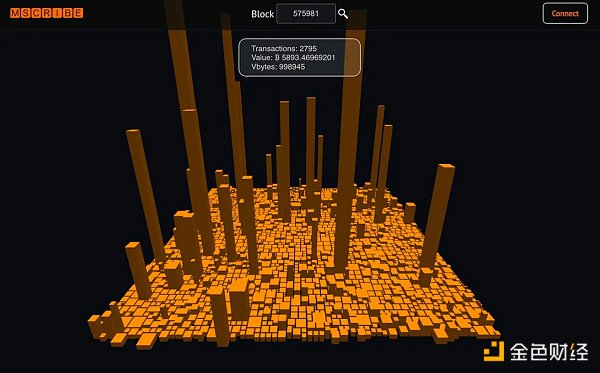
The well-known protocol BRC420 initially produced an avatar and bitmap NFT interaction protocol (using recursive inscription technology and exploring the conversion of graphics coins), forming The product bitmap.game is the most famous development team in the bitmap ecosystem. Subsequently, the team created a recursive inscription avatar generation platform (rcsv.io) and the BTC second-layer network Merlin Chain, and also changed the company's name to Bitmap Tech. So it should be noted here that Bitmap Tech and Bitmap Protocol are completely different things.
In the genesis issuance stage, the total amount of Bitmap that can be Mint is the Bitcoin block height. When the Bitmap standard was released, there were already more than 700,000 historical blocks. For historical blocks, users can freely choose to engrave them as long as they pay the mining fee. More than 700,000 historical blocks were registered within 2 months of the founder’s release.
The total amount of Bitmap is linked to the current block of Bitcoin. Bitcoin produces a block in about ten minutes. Therefore, the total amount is theoretically infinite. Every time a new block is generated in Bitcoin, there will be one more bitmap that can be registered (according to the rules, only engraving registration initiated after the block is mined is valid), following the first-come-first-served principle, allowing any People inscribe the plain text ordinals of the block number.bitmap to register the ownership of this block. So every day 144 new blocks are mined and available for registration. Currently, mainstream NFT exchanges will also update the total BITMAP amount in real time.
In terms of total volume, bitmap NFT is not scarce, so the current hype revolves around some special maps. For example,
1, special number, similar to 888.bitmap
2, according to the official Visualized data generates maps with special patterns, similar to cryptopunk
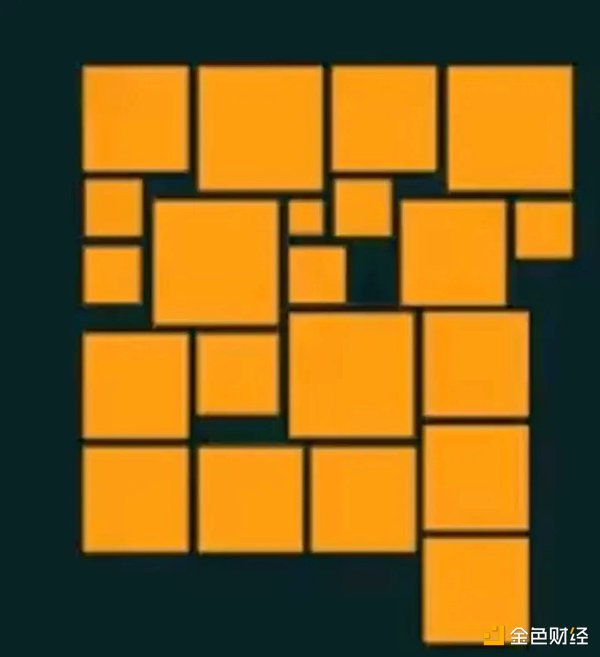
3, contains important historical blocks, such as the genesis block, pizza transaction block, etc.
In terms of infrastructure, more exploration comes from front-end rendering based on block data. Here are a few:


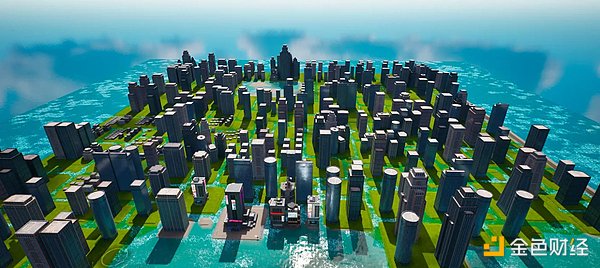
In summary, bitmap is actually an asset marking protocol that maps unowned assets "Bitcoin blocks" into NFTs through the Ordinal protocol and the bitmap protocol, thereby activating the asset attributes of the block and generating circulation and collection value.
LOOT of Bitcoin Ecosystem#
If bitmap cuts into the metaverse from the perspective of land, then rootverse (@ordinals_root) and BRC1024 (brc1024_pro) Just try to enter the metaverse in terms of characters and equipment, and the gameplay is similar to LOOT.
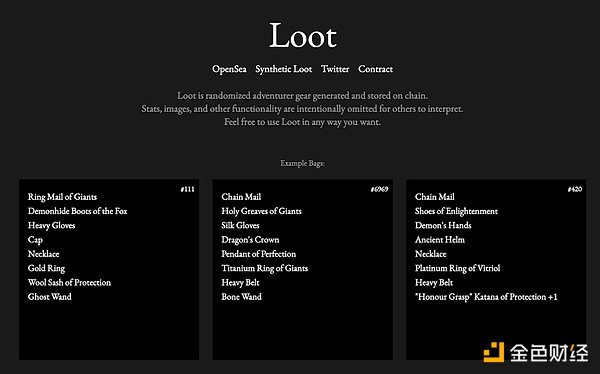
Ethereum’s LOOT we all prefer If you are familiar with it, it is a set of randomly combined text versions of NFT. This set of text descriptions defines the attributes of a piece of equipment, thus laying the foundation for a metaverse. Others can make decisions based on these text NFTs. Combinational derivatives, such as 2D picture presentation, 3D picture presentation, story presentation, etc.
BRC1024 is generally similar, that is, it specifies some parameters to define the components of the metaverse, as shown in the figure below, indicating that the ROOT metaverse has a component called "Charactor", its subcomponent is called "warrior", the maximum number of this subcomponent is 20,000, elements are several attributes of this subcomponent, some attributes even have multiple options, such as "skin color" attribute has white and copper color.
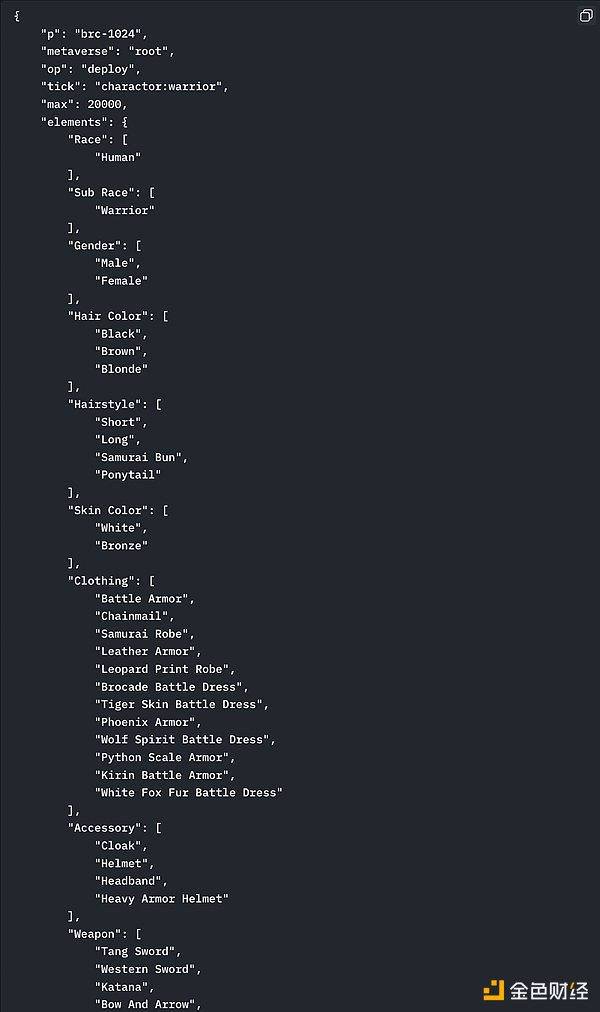
ROOT (official name Rootverse) is The project party used BRC1024 to establish the first metaverse, which stipulates 21 tribes (races and corresponding sub-races). Each sub-race has a different quantity. Players can cast it for free, totaling 210,000 character NFTs. As shown below:
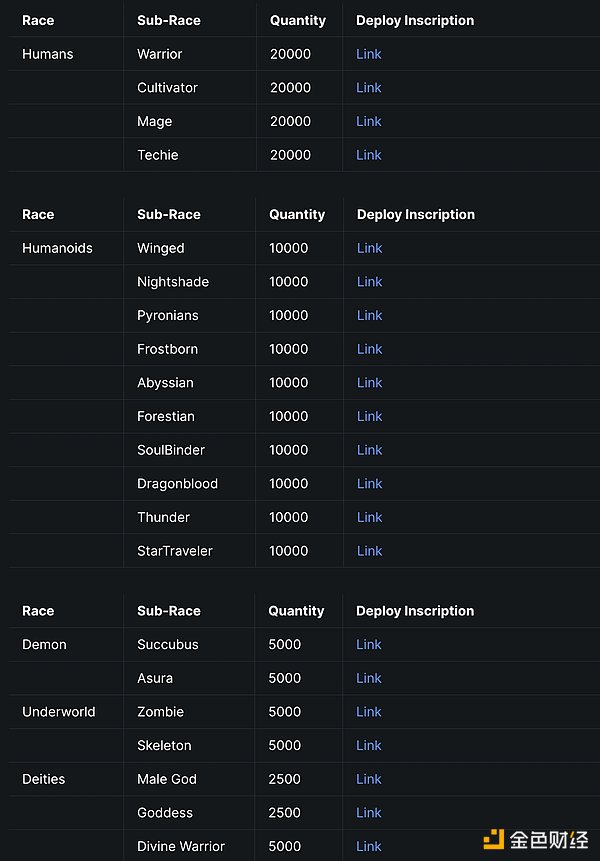
In summary, If BRC20 is to engrave the "code for issuing FT tokens" into the Segregated Witness space to implement the issuance of FT codes, then BRC1024 is to inscribe the "code for issuing Metaverse components" into the Segregated Witness space to implement the issuance of Metaverse components, and ROOT is to engrave the "code for issuing Metaverse components" into the Segregated Witness space to implement the issuance of Metaverse components. The component "Character Race" is inscribed. This is the embodiment of the composability of inscriptions.
Universal state machine for on-chain games#
Now that we have the map, characters and equipment of the metaverse, can we make a complete chain game based on the BTC chain? If it is the GameFi route that only puts assets (including NFT assets and FT assets) on the chain, the current infrastructure is enough, but for more crypto-native on-chain games (autonomous world), it is not enough.
Dojo of the Ethereum ecosystem first proposed the concept of “Provable Onchain Game”. Dojo is an on-chain game development framework. It is a verifiable game engine and tool chain built by the community for building on-chain games and autonomous worlds. Dojo allows game state and computation to be verified without a large consensus scheme. Games written in Cairo, Noir, and other languages or running RISC-Zero can run independently on a standalone browser-like zkVM, with verifiable output ensuring true execution. In other words, efficient VMs are used for calculations off the chain, and only data verification is done on the chain to ensure the authenticity and validity of the results, thereby achieving "trustlessness" and "decentralization."
Redux Protocol (@AutonomousRedux) refers to the concept of Dojo verifiable on-chain games and borrows Ordinal theory to implement an on-chain game development framework in the BTC ecosystem. . Although the BTC chain takes up to 10 minutes to generate blocks and has no smart contract function, the only way to realize on-chain games in the BTC ecosystem is through off-chain computing and on-chain verification.
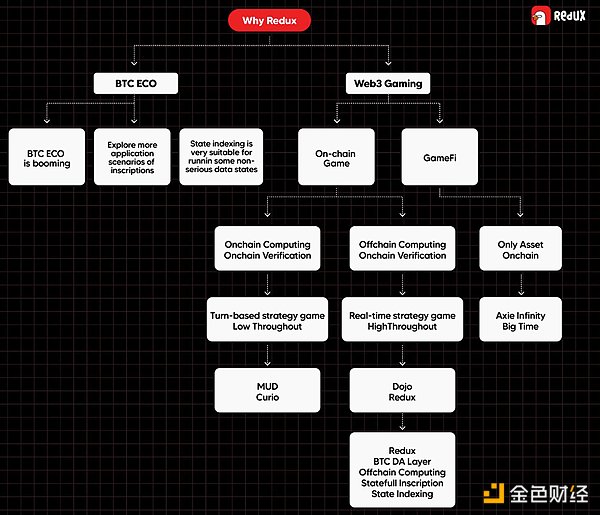
The interesting thing is that the Redux extension The usage scenario of “inscription” is explained. As we all know, previous inscriptions were basically used to issue coins, either Ordinal NFT tokens or FT tokens such as BRC20. Redux combines Merkle trees and inscriptions and proposes the concept of stateful inscription. In fact, it is to model and store the data of the characters and equipment attributes in the game in the form of Merkle trees, and ensure that the data cannot be tampered with. Whenever one place changes, the root hash changes.
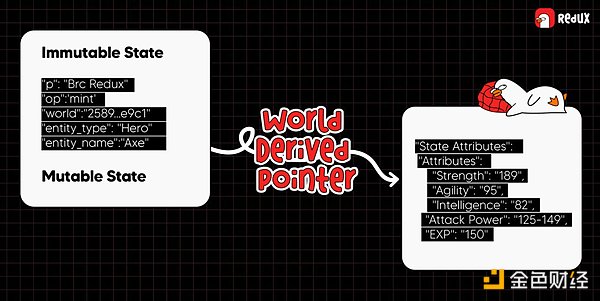
The specific method is to divide the status inscription into It has two parts, one part is the "immutable state", such as the weapon's health value, armor value, attack value, etc. This part is recorded on the BTC blockchain in the form of an inscription. The other part is "variable status", such as the specific data of health value, armor value and attack value mentioned before, which will change as the game progresses. This data is calculated and processed by the off-chain indexer. The "inscription" itself actually stores a pointer, which points to the variable state set of the inscription.
Developers are responsible for building the basic framework of the world and its status inscriptions. This includes defining which states are immutable (static) and which states are mutable (dynamic), while establishing the logic for user interaction with state inscriptions. The Redux protocol provides a runtime environment that allows developers to customize how players interact with status inscriptions. Players experience the game by interacting with status inscriptions.
From a technical perspective, it is a bit like Dojo or Paima. Dojo uses ZKP to create verifiable on-chain games, Paima uses NFT state compression to create verifiable on-chain games, and Redux uses state inscriptions (using Merkle trees). Another difference in making verifiable on-chain games is that Dojo uses Starknet as the DA layer, Paima uses its own sovereign rollup as the DA layer, and Redux uses the DA layer of the BTC ecosystem.
To sum up, we found that the above projects use the Ordinal protocol to explore different aspects of the game: Ordz is to inscribe the code of the web game on Chain, Bitmap uses BTC blocks as random data sources to map into map NFTs, ROOT engraves characters and equipment on the chain in the form of code, and Redux engraves the verifiable data of the state machine on the chain. If we have to make an analogy with projects in the Ethereum ecosystem, Ordz is analogous to TreasureDAO, Bitmap is analogous to SandBox and DecentraLand, ROOT is analogous to LOOT, and Redux is analogous to Dojo and Argus.
Reference materials
https://www.panewslab.com/zh/articledetails/leqfrx2o.html
https://gitbook.bitmap.land/
https://rcsv.gitbook.io/brc-420/
https://www.panewslab.com/zh/articledetails/22531q6583yt.html
https://www.brc1024.io/
< p style="text-align: left;">
https://mirror.xyz/0x62172Aa eb774F67F33769902CaD20356AC5859C2/ouEZuxR38yqRZcYjvUeVvV7iAFzBy_81fsJjy1QLcJc Weatherly
Weatherly


















